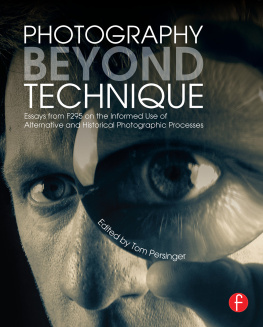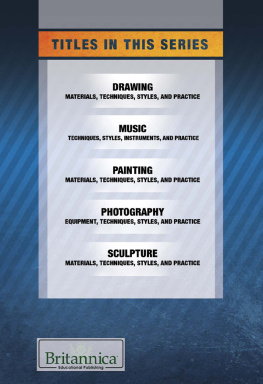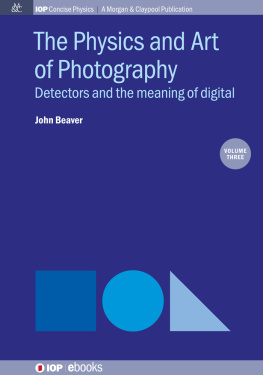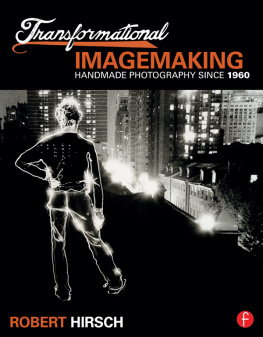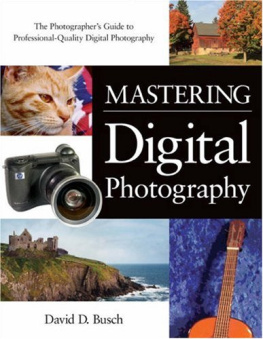
PHOTOGRAPHY
Beyond Technique
PHOTOGRAPHY
Beyond Technique
Essays from F295 on the Informed Use of Alternative and Historical Photographic Processes
Edited by
Tom Persinger

First published 2014
by Focal Press
70 Blanchard Road, Suite 402, Burlington, MA 01803
and by Focal Press
2 Park Square, Milton Park, Abingdon, Oxon OX14 4RN
Focal Press is an imprint of the Taylor & Francis Group, an informa business
2014 Tom Persinger
The right of the editor to be identified as the author of the editorial material, and of the authors for their individual chapters, has been asserted in accordance with sections 77 and 78 of the Copyright, Designs and Patents Act 1988.
All rights reserved. No part of this book may be reprinted or reproduced or utilized in any form or by any electronic, mechanical, or other means, now known or hereafter invented, including photocopying and recording, or in any information storage or retrieval system, without permission in writing from the publishers.
Notices
Knowledge and best practice in this field are constantly changing. As new research and experience broaden our understanding, changes in research methods, professional practices, or medical treatment may become necessary.
Practitioners and researchers must always rely on their own experience and knowledge in evaluating and using any information, methods, compounds, or experiments described herein. In using such information or methods they should be mindful of their own safety and the safety of others, including parties for whom they have a professional responsibility.
Product or corporate names may be trademarks or registered trademarks, and are used only for identification and explanation without intent to infringe.
Library of Congress Cataloging in Publication Data
A CIP application has been submitted.
ISBN: 978-0-415-81756-1 (pbk)
ISBN: 978-1-315-81883-2 (ebk)
Typeset in Minion Pro 10.5/12.5
Designed and Typeset By Tom Persinger
To Cindy, Sam, & Nate
TABLE OF CONTENTS
Tom Persinger
Dan Estabrook
Martha Casanave
John Metoyer
Craig Barber
Jill Enfield
Robert Hirsch
France Scully Osterman
Robb Kendrick
Stephen Berkman
Jo Babcock
Mark Osterman
Laura Blacklow
Carol Panaro-Smith and James Hajicek
Jesseca Ferguson
Tom Persinger
Brian Taylor
Jerry Spagnoli
Dan Burkholder
Keith Taylor
Alan Greene
APPENDIX 1:
F295 SYMPOSIA, SEMINAR, WORKSHOP & EXHIBITION
Most of all I wish to thank my wife Cindy and our sons Sam and Nate. Their support, patience, and understanding have been boundless. Its impossible to overstate how much their love and encouragement have meant.
Im grateful to each of the books contributors for taking the time to transform their F295 lecture(s) into a concise essay: Jo Babcock, Craig Barber, Stephen Berkman, Laura Blacklow, Dan Burkholder, Martha Casanave, Jill Enfield, Dan Estabrook, Jesseca Ferguson, Alan Greene, James Hajicek, Robert Hirsch, Robb Kendrick, John Metoyer, Mark Osterman, France Scully Osterman, Carol Panaro-Smith, Jerry Spagnoli, Brian Taylor, and Keith Taylor. It has been a pleasure to work with each of you.
Many thanks to the dozens of F295 speakers who generously traveled far and wide to grace our stage with their images, thoughts, secrets, successes, stories, and a few tales of failure.
Thanks to those who were instrumental in F295s evolution and/or have helped to bring its various events and functions to successful fruition: Susan Abramson, Jennifer Baron, Gabriel Biderman, David Brommer, Krista Campbell, Patrick Dellibovi, Scott Disabato, Nick Dvoracek, Wendy Erickson, Julie Gonzalez, Anna Houck, Ann Jastrab, Jennifer Diamond, Earl Johnson, Mark Johnson, Linda Benedict-Jones, Eric Joseph, Evan Mirapaul, Andrew Needham, Chris Peregoy, Marylin Russell, Judith Schacther, Lucy Stewart and countless others.
The following organizations have believed in the mission of F295 and have been important proponents and strong allies: B&H Photo and Video, the team at the B&H Photo Event Space, Carnegie Mellon University, The Camera Club of New York, The Carnegie Museum of Art, The Center for Arts in Society, The Daguerreian Society, Freestyle Photographic, The Mattress Factory, The Pittsburgh Cultural Trust, Pittsburgh Filmmakers, Pinhole Blender, Rayko Photo Center, San Francisco State University, Silver Eye Center for Photography, and The Society for Contemporary Craft.
Id like to thank Jerry Spagnoli for hosting myself, Dan Estabrook, and Robert Hirsch in his studio on a crisp fall day in 2012 for a lively and interesting discussion and debate on the current condition of photography.
I also wish to thank the wonderful team at Focal Press, both past and present. First and foremost Alison Duncan for her guidance, patience, and understanding, Emma Elder, Kimberly Duncan-Mooney, Carlin Regean, Sloane Stinson, and the team with whom I began this journey: Cara St. Hilaire and Valerie Geary. Cara and Valerie were early champions of the project and if not for their belief and effort, this book may not exist today. Im fortunate to work with such a great people.
I would like to also acknowledge Dr. Nenos Georgopolous who opened my eyes and mind to the ideas of the beautiful and the sublime. And also my high school art teacher Wesley Buterbaugh who taught some things it took me years to realize and appreciate.
And to all of the photographers, artists, members, contributors, and participants of the F295 website, symposia, seminars and workshops: youre each amazing. You have created something special, and Im humbled to be working with you.
Onward!
Contemporary masses are bent toward overcoming the uniqueness of every reality by accepting its reproduction.
Walter Benjamin
Tom Persinger
Photography is not dying and has not died. In fact, it is more vigorous than ever. The commonly felt angst (mostly among photographers) regarding the death of photography is because we have been tricked. Along the way, we were fooled into accepting a simplified definition of the medium. Photography is not simply a process, artifact, or gesture. It should not be reductively defined, but expansively considered. It is a visual language through which pictures and ideas can be shared, explored, and discussed. It is a way of communicating that can be chemical, digital, tangible, or ephemeral. It can be factual or fictitious. It can make us want things, satisfy our needs, and bridge great distances. Over its nearly 200 years of existence, it transformed our relationship with the world around us. Simultaneously, the medium itself changed and evolved.
For those who poured themselves into learning photographic process and technique, change can be hard to accept. Imagine how the daguerreotypists must have felt in the 1870s when an unorganized band of tintypists took their wagons and portable darkrooms to the streets. They crawled into every nook and cranny of America and sold cheap, but durable, photographs made on tin, for often less than a dollar a piece. I can image hearing a conversation between two daguerreotypists of the day: Photographs on blackened tin made in the streets with such messy edges? Blasphemy! That is not photography! Or later, in 1888, how disdainful must the reaction from the professional photographic community have been when George Eastman announced to the public that if you push the button, well do the rest!very little in the way of knowledge or technical expertise. If you could hold a camera and press a button, you too could make photographs. So simple even a child could do it, exclaimed one advertisement! A statement like that must have really worked the professionals into a lather.
Next page
